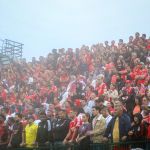
Why the Young Boys stadium is unique and hated
The blame lies with the (beautiful) artificial turf at Stadion Wankdorf
October 23rd, 2024
«Grass fields are better than artificial ones. 99% of top clubs play on grass, otherwise UEFA and FIFA would choose to play exclusively on artificial fields. It’s just common sense. In any case, if UEFA allows games to be played at Young Boys' stadium, it's because the pitch is in good condition. That's why we travel early when we come to Bern, to allow the players to get to the pitch sooner and better understand the surface: how the ball moves, how to sprint left, right, backward, and forward.» This is how Pep Guardiola, exactly 365 days ago, ahead of Manchester City's third Champions League match in last season's group stage against Young Boys, expressed his concerns about the pitch of the Bern-based club. Young Boys, which tonight hosts Inter at the Stadion Wankdorf, is one of the very few European teams — and the only one in the Champions League — to play on a synthetic field.
A handful of other European clubs also use synthetic fields: Boavista in Portugal, Lorient and Nancy in France, Zwolle, Volendam, and Heracles Almelo in the Netherlands, Novara and Cesena in Italy, but especially Bodø/Glimt (Norway) and Elfsborg (Sweden), tough opponents for Roma in recent editions of European competitions. It is no coincidence that such fields are preferred in countries characterized by cold climates with long and harsh winters: a high-quality synthetic turf shows remarkable resilience, withstanding ice and snow without deteriorating. In fact, during heavy rain and cold winters, it dries much faster than a natural grass field.
@kajapavlinic Some of my absolute favorite moments from @coldplay #worldofthespheres tour at #letzigrundstadion in #zurich #coldplayconcert #coldplay original sound - Kaja Pavlinić
UEFA regulations and limitations for Stadion Wankdorf
On the UEFA website, Article 35 concerning artificial pitches can be found. With the exception of the final, which must be played on natural grass, matches in the competition can be played on artificial turf, in accordance with UEFA Stadium Infrastructure regulations. Any stadium with an artificial turf pitch must have a valid FIFA Quality Pro certificate for the entire season of the competition; for the 2024/25 Champions League edition, this certification had to be provided by June 3, 2024. The chances of Stadion Wankdorf being chosen as a host venue for the Champions League final are almost non-existent, considering its 32,000-seat capacity, which would only make it suitable for a Conference League final. On this note, the Kombëtare Arena, which hosted the Conference League final between Roma and Feyenoord, accommodates fewer than 20,000 spectators.
@bluesport_fr Young Boys Europa League #bscyoungboys #bscyb #bern #berne #football #ucl #ldc #championsleague #liguedeschampions #uefa #europealeague son original - blue Sport
How the pitch at Stadion Wankdorf was made
The pitch at Stadion Wankdorf – also known as Stade de Suisse and owned by Young Boys – is almost unique in the country, as another synthetic field in Switzerland is the small Stade de la Maladière in Neuchâtel. The construction of the field was handled by the German company Polytan, specializing in the installation of sports surfaces and athletics tracks. Polytan has seen significant growth year after year, both in Europe and globally. For example, for the first time in 2015, all matches of the Women's World Cup were played on synthetic turf. Polytan provided a synthetic grass system for the BC Place stadium in Vancouver, which hosted the final, introducing a new concept that UEFA is still cautious about adopting. Stadion Wankdorf is also a multifunctional facility, a true multi-sport arena that is adapted for various sports, from football to rugby to hockey.
The skepticism of clubs and coaches
The skepticism of clubs, coaches, and teams towards synthetic pitches often arises from the need to adapt, for just ninety minutes, to a different style of play, but also from facing opponents who, being used to playing on such surfaces, might have an advantage. However, today there is increasing discussion about the issue of injuries, which are becoming more frequent due to the numerous matches players are required to play throughout the season. Surfaces like these only increase the risk of such incidents.












